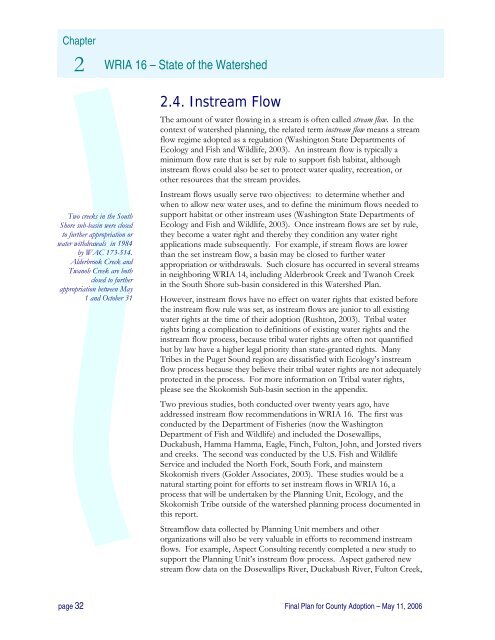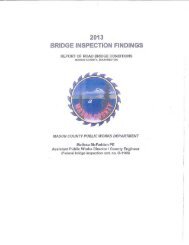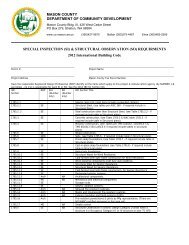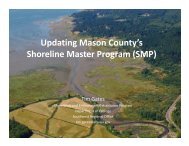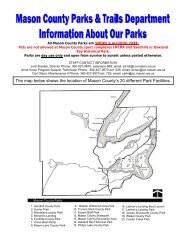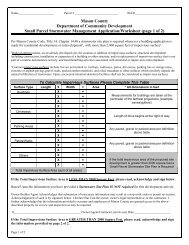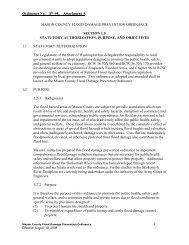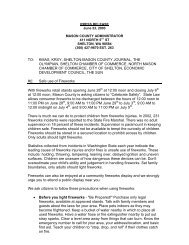Watershed Management Plan - Mason County
Watershed Management Plan - Mason County
Watershed Management Plan - Mason County
Create successful ePaper yourself
Turn your PDF publications into a flip-book with our unique Google optimized e-Paper software.
Chapter<br />
2 WRIA 16 – State of the <strong>Watershed</strong><br />
Two creeks in the South<br />
Shore sub-basin were closed<br />
to further appropriation or<br />
water withdrawals in 1984<br />
by WAC 173-514.<br />
Alderbrook Creek and<br />
Twanoh Creek are both<br />
closed to further<br />
appropriation between May<br />
1 and October 31<br />
2.4. Instream Flow<br />
The amount of water flowing in a stream is often called stream flow. In the<br />
context of watershed planning, the related term instream flow means a stream<br />
flow regime adopted as a regulation (Washington State Departments of<br />
Ecology and Fish and Wildlife, 2003). An instream flow is typically a<br />
minimum flow rate that is set by rule to support fish habitat, although<br />
instream flows could also be set to protect water quality, recreation, or<br />
other resources that the stream provides.<br />
Instream flows usually serve two objectives: to determine whether and<br />
when to allow new water uses, and to define the minimum flows needed to<br />
support habitat or other instream uses (Washington State Departments of<br />
Ecology and Fish and Wildlife, 2003). Once instream flows are set by rule,<br />
they become a water right and thereby they condition any water right<br />
applications made subsequently. For example, if stream flows are lower<br />
than the set instream flow, a basin may be closed to further water<br />
appropriation or withdrawals. Such closure has occurred in several streams<br />
in neighboring WRIA 14, including Alderbrook Creek and Twanoh Creek<br />
in the South Shore sub-basin considered in this <strong>Watershed</strong> <strong>Plan</strong>.<br />
However, instream flows have no effect on water rights that existed before<br />
the instream flow rule was set, as instream flows are junior to all existing<br />
water rights at the time of their adoption (Rushton, 2003). Tribal water<br />
rights bring a complication to definitions of existing water rights and the<br />
instream flow process, because tribal water rights are often not quantified<br />
but by law have a higher legal priority than state-granted rights. Many<br />
Tribes in the Puget Sound region are dissatisfied with Ecology’s instream<br />
flow process because they believe their tribal water rights are not adequately<br />
protected in the process. For more information on Tribal water rights,<br />
please see the Skokomish Sub-basin section in the appendix.<br />
Two previous studies, both conducted over twenty years ago, have<br />
addressed instream flow recommendations in WRIA 16. The first was<br />
conducted by the Department of Fisheries (now the Washington<br />
Department of Fish and Wildlife) and included the Dosewallips,<br />
Duckabush, Hamma Hamma, Eagle, Finch, Fulton, John, and Jorsted rivers<br />
and creeks. The second was conducted by the U.S. Fish and Wildlife<br />
Service and included the North Fork, South Fork, and mainstem<br />
Skokomish rivers (Golder Associates, 2003). These studies would be a<br />
natural starting point for efforts to set instream flows in WRIA 16, a<br />
process that will be undertaken by the <strong>Plan</strong>ning Unit, Ecology, and the<br />
Skokomish Tribe outside of the watershed planning process documented in<br />
this report.<br />
Streamflow data collected by <strong>Plan</strong>ning Unit members and other<br />
organizations will also be very valuable in efforts to recommend instream<br />
flows. For example, Aspect Consulting recently completed a new study to<br />
support the <strong>Plan</strong>ning Unit’s instream flow process. Aspect gathered new<br />
stream flow data on the Dosewallips River, Duckabush River, Fulton Creek,<br />
page 32 Final <strong>Plan</strong> for <strong>County</strong> Adoption – May 11, 2006


